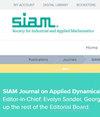差异建模框架:学习缺失物理、系统残差建模以及区分确定性效应和随机效应
IF 1.8
4区 数学
Q2 MATHEMATICS, APPLIED
引用次数: 0
摘要
SIAM 应用动力系统期刊》第 23 卷第 1 期第 440-469 页,2024 年 3 月。 摘要.基于物理学和第一原理的模型遍布工程和物理科学领域,能够以规定的精度建立复杂系统的动力学模型。在推导控制方程时使用的近似值往往会造成模型与基于传感器的系统测量结果之间的差异,从而暴露出方程的近似性质和/或传感器本身的信噪比。在现代动力系统中,模型与测量之间的这种差异会导致量化效果不佳,往往会削弱精确控制算法的能力。我们引入了一个差异建模框架,通过两种不同的方法来识别缺失的物理现象并解决模型与测量不匹配的问题:(i) 学习系统状态空间残差演化模型;(ii) 发现确定性动态误差模型。无论采用哪种方法,都可以使用一套通用的数据驱动模型发现方法。具体来说,我们使用四种基本不同的方法来演示差异建模的数学实现:(i) 非线性动力学稀疏识别,(ii) 动态模式分解,(iii) 高斯过程回归,以及 (iv) 神经网络。方法的选择取决于差异建模的意图(如机理可解释性)、传感器测量特性(如数量、质量、分辨率)以及实际应用的限制(如状态或动态空间的可操作性)。我们在不同信噪比条件下的四个动力系统上使用数据驱动建模方法套件,展示了差异建模的实用性和适用性。最后,我们强调了每种差异建模方法因误差类型不同而存在的结构性缺陷。总之,如果真实动力学是未知的(即不完美模型),我们应该学习动力学空间中缺失物理的差异模型。然而,如果真正的动力学是已知的,但模型-测量不匹配仍然存在,则应在状态空间中学习差异模型。本文章由计算机程序翻译,如有差异,请以英文原文为准。
Discrepancy Modeling Framework: Learning Missing Physics, Modeling Systematic Residuals, and Disambiguating between Deterministic and Random Effects
SIAM Journal on Applied Dynamical Systems, Volume 23, Issue 1, Page 440-469, March 2024.
Abstract.Physics-based and first-principles models pervade the engineering and physical sciences, allowing for the ability to model the dynamics of complex systems with a prescribed accuracy. The approximations used in deriving governing equations often result in discrepancies between the model and sensor-based measurements of the system, revealing the approximate nature of the equations and/or the signal-to-noise ratio of the sensor itself. In modern dynamical systems, such discrepancies between model and measurement can lead to poor quantification, often undermining the ability to produce accurate and precise control algorithms. We introduce a discrepancy modeling framework to identify the missing physics and resolve the model-measurement mismatch with two distinct approaches: (i) by learning a model for the evolution of systematic state-space residual, and (ii) by discovering a model for the deterministic dynamical error. Regardless of approach, a common suite of data-driven model discovery methods can be used. Specifically, we use four fundamentally different methods to demonstrate the mathematical implementations of discrepancy modeling: (i) the sparse identification of nonlinear dynamics, (ii) dynamic mode decomposition, (iii) Gaussian process regression, and (iv) neural networks. The choice of method depends on one’s intent (e.g., mechanistic interpretability) for discrepancy modeling, sensor measurement characteristics (e.g., quantity, quality, resolution), and constraints imposed by practical applications (e.g., state- or dynamical-space operability). We demonstrate the utility and suitability for discrepancy modeling using the suite of data-driven modeling methods on four dynamical systems under varying signal-to-noise ratios. Finally, we emphasize structural shortcomings of each discrepancy modeling approach depending on error type. In summary, if the true dynamics are unknown (i.e., an imperfect model), one should learn a discrepancy model of the missing physics in the dynamical space. Yet, if the true dynamics are known yet model-measurement mismatch still exists, one should learn a discrepancy model in the state space.
Abstract.Physics-based and first-principles models pervade the engineering and physical sciences, allowing for the ability to model the dynamics of complex systems with a prescribed accuracy. The approximations used in deriving governing equations often result in discrepancies between the model and sensor-based measurements of the system, revealing the approximate nature of the equations and/or the signal-to-noise ratio of the sensor itself. In modern dynamical systems, such discrepancies between model and measurement can lead to poor quantification, often undermining the ability to produce accurate and precise control algorithms. We introduce a discrepancy modeling framework to identify the missing physics and resolve the model-measurement mismatch with two distinct approaches: (i) by learning a model for the evolution of systematic state-space residual, and (ii) by discovering a model for the deterministic dynamical error. Regardless of approach, a common suite of data-driven model discovery methods can be used. Specifically, we use four fundamentally different methods to demonstrate the mathematical implementations of discrepancy modeling: (i) the sparse identification of nonlinear dynamics, (ii) dynamic mode decomposition, (iii) Gaussian process regression, and (iv) neural networks. The choice of method depends on one’s intent (e.g., mechanistic interpretability) for discrepancy modeling, sensor measurement characteristics (e.g., quantity, quality, resolution), and constraints imposed by practical applications (e.g., state- or dynamical-space operability). We demonstrate the utility and suitability for discrepancy modeling using the suite of data-driven modeling methods on four dynamical systems under varying signal-to-noise ratios. Finally, we emphasize structural shortcomings of each discrepancy modeling approach depending on error type. In summary, if the true dynamics are unknown (i.e., an imperfect model), one should learn a discrepancy model of the missing physics in the dynamical space. Yet, if the true dynamics are known yet model-measurement mismatch still exists, one should learn a discrepancy model in the state space.
求助全文
通过发布文献求助,成功后即可免费获取论文全文。
去求助
来源期刊

SIAM Journal on Applied Dynamical Systems
物理-物理:数学物理
CiteScore
3.60
自引率
4.80%
发文量
74
审稿时长
6 months
期刊介绍:
SIAM Journal on Applied Dynamical Systems (SIADS) publishes research articles on the mathematical analysis and modeling of dynamical systems and its application to the physical, engineering, life, and social sciences. SIADS is published in electronic format only.
 求助内容:
求助内容: 应助结果提醒方式:
应助结果提醒方式:


